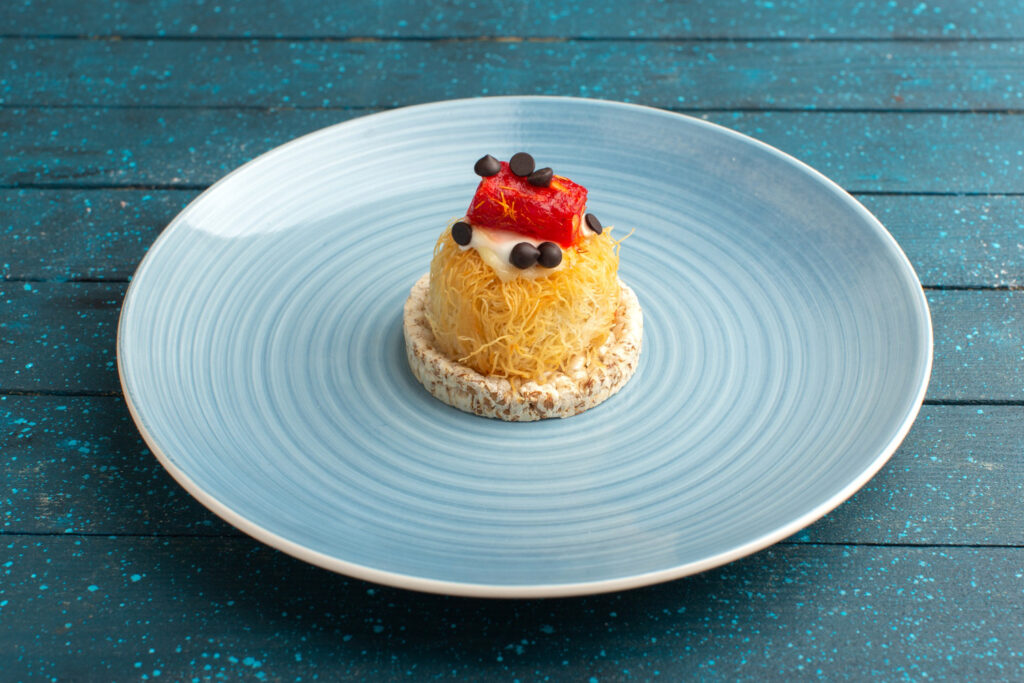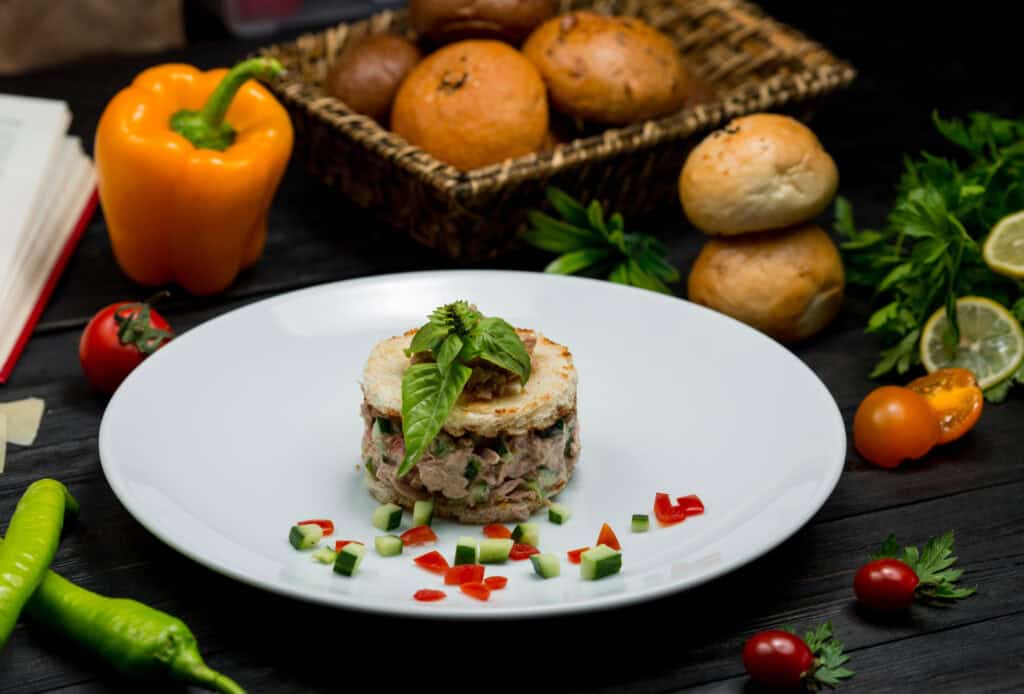
By Jermaine Thomas June 3, 2025
Plating Style is just as important as flavour when it comes to dining. How you present food can improve the whole dining experience, whether you’re a professional caterer creating a tasting menu or a home cook entertaining guests. Modern plating techniques are dominated by two aesthetics: maximalist and minimalist. Each has a distinct emotional and visual impact. So, how do you pick the best strategy for your visitors?
Understanding the Minimalist Approach
Minimalist plating is all about simplicity and precision. It emphasizes clean lines, limited color palettes, and uncluttered compositions. The focus is often on one or two main elements on the plate, with minimal garnishes or sauces. Every component has a purpose. Minimalist plating is influenced by Japanese cuisine, Nordic aesthetics, and modernist culinary trends. It often appeals to diners who appreciate balance, subtlety, and attention to detail. Think of a single seared scallop on a porcelain plate, paired with a carefully brushed sauce and microgreens. The message here is restraint and refinement.
One advantage of minimalist plating techniques is that they spotlight the quality and freshness of ingredients. When done well, this style communicates confidence in your culinary choices. It also leaves more room for the diner’s imagination, allowing them to focus on flavors without visual distractions. However, this style can also appear stark or underwhelming if not executed properly. The risk lies in making the dish look unfinished or sparse. Mastering minimalism requires discipline and a keen eye for detail.
Exploring the Maximalist Style
The maximalist style, which emphasises texture, colour, abundance, and visual storytelling, is at the other extreme. It involves assembling various components into a visually stunning display that is expressive and often dramatic. Baroque and Indian design, as well as eclectic fusion cuisine, are sources of inspiration for maximalist plating. The same plate may have a variety of garnishes, stacked ingredients, colourful purees, and edible flowers. Wonder, excitement, and indulgence are the goals of this strategy.
One of the biggest strengths of maximalist food styling ideas is the sense of adventure it offers. It allows chefs to express creativity and surprise the diner with complex arrangements and playful combinations. It’s especially popular at weddings, food festivals, and tasting events where visual impact is a priority. On the downside, too much going on can overwhelm the senses or obscure the flavor focus. Poorly executed maximalist plating can result in messy or chaotic dishes. The key lies in balancing abundance with harmony.

Considering Your Audience
Choosing between minimalist and maximalist elegant food presentation starts with understanding your audience. Who are your guests? What kind of event are you hosting? What mood do you want to create? For corporate dinners, tasting menus, or upscale gatherings, minimalist plating often feels more refined and appropriate. It aligns well with formal settings and allows for a more introspective dining experience.
In contrast, family gatherings, festive celebrations, or themed dinners may benefit from the energy of maximalist styling. A lavishly plated dish can mirror the joy and openness of the event, encouraging shared enjoyment and conversation. Cultural context also plays a role. Guests familiar with traditional or richly layered cuisines may expect a fuller plate with multiple components. Others who appreciate modern gastronomy may favor the sophistication of minimalist design.
Understanding these expectations helps you tailor your plating to suit not only your ingredients but also the emotional tone of the meal.
The Role of Color and Texture
Whether you lean minimalist or maximalist, plating techniques are deeply influenced by color and texture. A well-composed dish uses these elements intentionally to create contrast, highlight ingredients, and evoke appetite. In minimalist styles, colors are often neutral or focused. A white plate with a pop of green or a hint of red can create a striking focal point. Texture is used sparingly but meaningfully, like a crisp tuile against a creamy mousse.
Conversely, maximalist plating benefits greatly from striking contrasts. Imagine golden roasted carrots with a beetroot puree on the side, garnished with a glossy balsamic drizzle and crushed pistachios. These foods appeal to the eye just as much as the taste buds. Try to use a variety of textures, regardless of style. Tender proteins, crunchy garnishes, and smooth sauces combine to create a delightful meal. The theory of colour can also be useful. Cooler colours like blue or green add calm and freshness, while warmer colours like orange and yellow can make a dish feel warm and inviting.
Experimenting with these sensory elements allows you to refine your visual storytelling, no matter which plating path you choose.
Balancing Composition and Space
Composition is one of the foundational principles in elegant food presentation. How you place each component affects how the dish is perceived and consumed. Minimalist plates often use negative space intentionally, letting the eye rest and drawing focus to the key ingredient. A minimalist dish may follow the “golden ratio” or use asymmetry to guide visual flow. Placement is deliberate, and nothing is wasted. The plate acts like a canvas, and the food becomes part of a quiet but powerful image.
Maximalist compositions, while fuller, also need thoughtful arrangement. The challenge is to avoid visual clutter. Layering ingredients vertically or in clusters can help create structure. Odd numbers, diagonal lines, or circular patterns add rhythm and movement to the plate. Whichever style you choose, aim for visual balance. Don’t let one side of the plate feel too heavy. Use sauces to connect different areas or garnishes to soften transitions. Proper composition turns food into art, and this applies to both minimalist and maximalist approaches.
Plate Size and Shape Matter
Your plating methods can be significantly impacted by the plate or platter you choose. Large plates with clean lines and wide rims work well for minimalist dishes. These provide a distraction-free area for displaying the ingredient. To accommodate different textures and components, maximalist dishes often make use of bowls, deep plates, or even multi-layered serving sets. The presentation can gain personality from the shape. A rustic wooden board adds warmth and a touch of casual charm, while a square plate might suggest modernity.
Using the right vessel also supports function. For example, a deep bowl retains sauce for a pasta dish better than a flat plate. In desserts, tall glasses or tiered stands can add height and drama. Don’t underestimate the power of matching the plate to the story you want to tell. Whether it’s sleek porcelain for fine dining or a colorful ceramic platter for family-style meals, your choice helps set the tone.
Garnishing with Purpose
Garnishes are more than decorative flourishes. They are essential tools in both minimalist and maximalist food styling ideas. The key is to garnish with purpose, not excess. In minimalist plating, a single herb leaf, a few microgreens, or a dusting of spice can enhance both flavor and presentation. It should feel intentional and harmonious with the rest of the dish.
Maximalist garnishes can be more adventurous. Edible flowers, crushed nuts, flavored oils, and dehydrated fruits all offer color and texture. However, each should contribute something meaningful; taste, aroma, or symbolism. Avoid using garnishes that don’t make sense with the dish. Every item on the plate should be edible and add value. A thoughtful garnish ties the visual and gustatory elements together, completing the experience.
Seasonal and Thematic Plating Style
Relevance and engagement can be increased by matching your plating style to the meal’s theme or season. Simple meals that feature vibrant vegetables and fresh herbs can feel light and refreshing in the spring and summer. The seasons of autumn and winter are ideal for maximalist presentations. The abundance of the season is reflected in roasted root vegetables, flavourful sauces, and layered textures.
Maximalist designs may incorporate shaped or color-coordinated elements for themed events such as Halloween or Valentine’s Day. On the other hand, a minimalist theme dinner might use geometric shapes or monochromatic plating to add interest. Using plating techniques that are appropriate for the time and occasion enhances the overall dining experience and shows thoughtfulness.
Working with Dietary Preferences
Plating style also intersects with dietary trends and health-conscious dining. Minimalist presentation often aligns well with clean eating, vegan meals, or high-end wellness cuisine. The visual simplicity reflects the purity of ingredients and appeals to diners seeking balance. Maximalist plating can be adapted for plant-based meals, comfort food, or fusion dining. It allows for creative exploration with global spices, protein substitutes, and colorful grains.
Being mindful of allergies, restrictions, and cultural preferences while still offering elegant food presentation demonstrates hospitality and skill. It also opens opportunities for innovation, challenging you to present familiar ingredients in new, exciting ways.
Combining Styles for Modern Impact
In reality, combining the two approaches works well for many chefs and hosts. To create suspense, a minimalist starter might be used, followed by a maximalist main that engages the senses. A clean finish is often achieved by desserts, which often return to minimalist elegance. This method avoids visual fatigue and keeps the meal interesting. Additionally, it allows for contrast manipulation, demonstrating adaptability and thoughtfulness.
A single plate can also be used for hybridisation. Create visual focus by framing a maximalist spread with minimalist elements or using a minimalist layout with a bold garnish. Practice is necessary for this type of fusion, but the benefits are substantial. By being aware of both styles, you can make intentional choices that capture the essence of the dish, your guests’ expectations, and your own personality.

Conclusion
Regardless of your preference for the rich, expressive flair of maximalism or the crisp, elegant lines of minimalism, your plating choices have an impact. They convey respect for the ingredients as well as mood and intention. The type of experience you wish to provide, context, and inventiveness all play a role in selecting the ideal style for your guests. Your meals can become memorable experiences by improving your plating methods and experimenting with different food styling concepts. Elegant food presentation is ultimately about connection rather than trends. Before the first bite, it’s a visual handshake that conveys your level of concern as a chef or host.